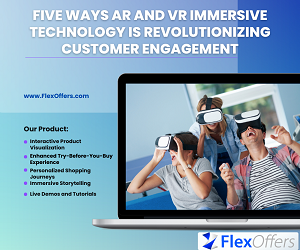 A vital skill in the fast-paced world of affiliate marketing is staying on top of technology developments. Virtual reality (VR) and augmented reality (AR) are two such innovations that are changing the environment. These immersive technologies are revolutionizing the affiliate marketing industry as well. They are no longer just for entertainment and gaming. We’ll look at five significant ways that AR and VR immersive technology is transforming how affiliate marketers engage with clients in this blog post.
A vital skill in the fast-paced world of affiliate marketing is staying on top of technology developments. Virtual reality (VR) and augmented reality (AR) are two such innovations that are changing the environment. These immersive technologies are revolutionizing the affiliate marketing industry as well. They are no longer just for entertainment and gaming. We’ll look at five significant ways that AR and VR immersive technology is transforming how affiliate marketers engage with clients in this blog post.
1. Interactive Product Visualization
Customers can now interact with goods and services in novel ways thanks to AR and VR immersive technology. Customers can use augmented reality (AR) to superimpose virtual versions of goods into their actual surroundings, which helps them envision how goods will appear before making a purchase. Contrarily, virtual reality (VR) immerses customers in computer-generated worlds or showrooms where they can interact with things as if they were real. This can result in a more interesting and educated purchasing experience for affiliate marketers, which may increase conversion rates.
2. Enhanced Try-Before-You-Buy Experience
A game-changer is the ability to virtually test things before buying them. Customers can virtually “try on” apparel, accessories, makeup, and even furniture from the convenience of their homes thanks to augmented reality (AR). Customers may test out a variety of scenarios in lifelike simulations created by virtual reality, from test-driving autos to examining how a new kitchen design fits their space. Affiliate marketers may take advantage of this by working with companies to offer engaging previews that boost consumer confidence and lower returns.
3. Personalized Shopping Journeys
By adjusting experiences to user preferences, AR and VR immersive technology provides a personalized shopping journey. Consider a virtual store where merchandise is shown in accordance with a customer’s browsing patterns, preferences, and style. With the help of these technologies, affiliate marketers can design engaging, focused experiences that give customers the impression that they are getting personalized advice and recommendations. This increases customer engagement and conversions.
4. Immersive Storytelling
Exciting new opportunities for immersive storytelling are provided by AR and VR. Customers can be transported inside the brand’s story by marketers, creating a richer and more lasting experience. Consider allowing customers to investigate the origins of a product or the principles that underpin a company by taking them on a virtual tour of the production process. Affiliate marketers may create stronger bonds and encourage brand loyalty by submerging clients in the world of the brand.
5. Live Demos and Tutorials
With AR and VR, live demos and lessons take on a new dimension. Affiliate marketers are able to hold online training courses, product demonstrations, or workshops. Without leaving their homes, customers may explore features, ask questions, and gain first-hand experience. This level of involvement presents affiliate marketers as useful providers of knowledge and information in addition to efficiently showcasing products.
The way affiliate marketers interact with clients is changing as a result of augmented reality (AR) and virtual reality (VR). A small sample of the transformative power of these technologies includes interactive product visualization, improved try-before-you-buy experiences, personalized shopping trips, immersive storytelling, and live demos. Affiliate marketers who take advantage of the possibilities of AR and VR immersive technology will be able to develop more interesting, significant, and customized client encounters. Embrace the digital revolution to open up new opportunities for success in affiliate marketing.